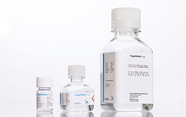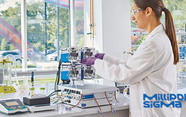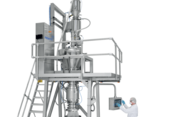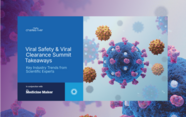Inhalable Gene Therapies? Here’s How They Could Work
Scientists explain how inhalable gene therapies are being developed to treat cystic fibrosis.
Stephanie Vine | | 5 min read | Future

Dr. Brigitte Gomperts, Dr. Donald Kohn and Dr. Steven Jonas | Credit: Elena Zhukova/UCLA Broad Stem Cell Research Center
We’ve come a long way in treatments for cystic fibrosis (CF) that extend lifespans. In 2008, the average lifespan of CF patients was just 26 years. Today, patients can live to their 60s. The advances have been remarkable but there is still no cure.
CF stems from mutations in a single gene that encodes for the cystic fibrosis transmembrane conductance receptor (CFTR). This means that gene therapy – delivered to the lungs as an inhalable package – could be an option. Several research institutes and startups are working in this area, including the University of California, Los Angeles (UCLA).
There are over 2000 mutations in the CFTR gene that can result in the CF disease phenotype. UCLA physician-scientists Brigitte Gomperts (associate director of translational research at the UCLA Broad Stem Cell Research Center – and an expert in pulmonary medicine), Donald Kohn (distinguished professor, microbiology, immunology and molecular genetics – and an expert in cell and gene therapies), and Steven Jonas (assistant professor of pediatrics – and an expert in nanotechnology) are collaborating to explore gene editing approaches designed to make small edits to individual disease-causing mutations, as well as a potential “all-in-one strategy” where an entire copy of CFTR is inserted to correct all CF-causing mutations.
We spoke with them to learn more about their work.
Who is involved in this work and what progress has been made so far?
Our work so far has focused on leveraging the collective expertise of our multidisciplinary teams. Dr. Gomperts leads our effort to identify long-lived stem cell populations of the human airway that offer the most potential for therapeutic gene correction and is working to advance organoid models that mimic the areas of the airway where these cells reside. Dr. Kohn’s lab focuses on the gene editing reagents necessary to correct mutations that cause CF, and Dr. Jonas and his team are leveraging advances in nanotechnology and bioengineering to design nanoparticle shipping containers that can package these reagents and facilitate their transport to the airway stem cell populations by Gomperts.
We also benefit from a collaboration established with the Cystic Fibrosis Foundation’s Therapeutics lab, as well as with UC San Diego’s Dr. Beate Illek, an electrophysiology expert with a long track record of CF research who guides our efforts to test whether the airway stem cells we are targeting exhibit restored function upon gene editing.
Inhaled drug delivery is challenging for even standard drug molecules. What challenges will you face in delivering a gene therapy in an inhaled format?
Effective inhaled delivery to the dysfunctional airway of CF patients presents several considerable challenges. The pathophysiology of CF results in mutations that lead to defective activity of CFTR, which regulates the salt balance at different epithelial layers in patients. This maladaptive activity prevents the mucociliary epithelium of the airway from establishing its normal protective hydration layer, which leads to the formation of thick, dehydrated mucus that is difficult to clear. As this mucus builds up, patients develop frequent infections and irreparable damage in the form of progressive pulmonary scarring.
If we can circumvent this mucus layer, we also need to ensure that the nanoparticles and their gene editing cargo reach the specific, long-lived cells in the airway that, when corrected, would offer the best chance at a permanent cure. While existing nanoparticle-based delivery strategies have demonstrated some delivery efficacy and tropism to the lungs, they have not yet been programmed to target specific cell populations of the airway. We liken this targeting specificity problem to having the capability to reach a particular city or zip code in lung tissue, but for gene therapy solutions we’ll need to take the capabilities of the nanocarriers to the next step so they can reach the specific street and home address.
What will be involved in targeting delivery to the lungs?
We are working on strategies to decorate the nanoparticles with different biomolecules that enable targeting of and internalization into the airway stem cells. We have also, in parallel, considered integrating soap-like molecules that can enable the particles to penetrate the thick mucus barrier coating the CF airway, and then transiently disrupt the airway epithelial layer to expose the stem cells that need to be corrected for long-term therapeutic effect.
For inhalable delivery, we want to configure our nanoparticles to remain stable as they transit to the airway as a mist that consists of suspensions of nebulized droplets. We are considering different nebulization strategies and droplet configurations that effectively reach the regions of the airway we want to target.
What new technologies would you like to see in the gene therapy/gene editing field to help your work?
Technologies that would help accelerate the advance of CF gene therapies into clinical practice include: i) gene editing tools that enable more efficient and reliable insertion of constructs large enough to accommodate the entire CFTR gene; and ii) solutions that address the delivery specificity issue discussed above and achieve effective correction of long-lived airway stem cells efficiently and rigorously. An important requirement for these technologies will also be to identify solutions that offer the opportunity to improve access and widely disseminate CF gene therapies.
Cystic fibrosis remains an area of unmet needs; why has the disease proven so difficult to treat?
There have been tremendous advances in developing medications to modulate the activity of the defective CFTR that have transformed the care of many patients with CF. Unfortunately, these treatments only work on certain common CF mutations. While they can improve the quality of life and extend overall survival in 80-90 percent of patients, roughly 10 percent of patients have CFTR mutations that will not respond to modulator therapies. It is also notable that these rare CFTR mutations tend to be more prevalent in historically underrepresented groups, underscoring the need for developing broadly applicable gene therapy solutions that can be disseminated rapidly and easily accessed by patients in need.
We hope that multidisciplinary efforts like ours will ultimately inspire other groups to join the CF research community and better enable us to contribute to our collective goal of establishing gene therapy tools that offer a robust and definitive cure for CF.

Making great scientific magazines isn’t just about delivering knowledge and high quality content; it’s also about packaging these in the right words to ensure that someone is truly inspired by a topic. My passion is ensuring that our authors’ expertise is presented as a seamless and enjoyable reading experience, whether in print, in digital or on social media. I’ve spent fourteen years writing and editing features for scientific and manufacturing publications, and in making this content engaging and accessible without sacrificing its scientific integrity. There is nothing better than a magazine with great content that feels great to read.



















